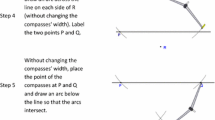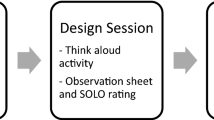Abstract
Research focusing on the complexities faced by instructional designers have called for pedagogical strategies to equip instructional designers with the ability to problem solve and make decisions. One of the most widely studied strategies for managing cognitive load is the use of worked examples, which provides an alternative to traditional problem solving by presenting the learner with a step-by-step model for approaching and solving a problem. This paper synthesizes the literature examining how worked examples are being used as an instructional strategy to promote solving ill-structured problems in various disciplines. It is argued that incorporating instructional heuristics utilizing worked examples will alleviate cognitive load imposed on instructional designers as they acquire skills to demonstrate mastery in conceptual, strategic, and conditional knowledge domains.

Similar content being viewed by others
References
Blayney, P., Kalyuga, S., & Sweller, J. (2010). Interactions between the isolated-interactive elements effect and levels of learner expertise: Experimental evidence from an accountancy class. Instructional Science, 38(3), 277–287.
Blayney, P., Kalyuga, S., & Sweller, J. (2015a). The impact of complexity on the expertise reversal effect: Experimental evidence from testing accounting students. Educational Psychology: An International Journal of Experimental Educational Psychology, https://doi.org/10.1080/01443410.2015.1051949
Blayney, P., Kalyuga, S., & Sweller, J. (2015b). Using cognitive load theory to tailor instruction to levels of accounting students’ expertise. Educational Technology & Society, 18(4), 199–210.
Bokosmaty, S., Sweller, J., & Kalyuga, S. (2015). Learning geometry problem solving by studying worked examples: Effects of learner guidance and expertise. American Educational Research Journal, 52(2), 307–333.
Boling, E., Easterling, W. V., Hardre, P. L., Howard, C. D., & Roman, R. A. (2011). ADDIE: Perspectives in transition. Educational Technology, 51(5), 34–38.
Branch, R. M., & Kopcha, T. J. (2014). Instructional design models. In Handbook of research on educational communications and technology (pp. 77–87). New York: Springer.
Chang, T. W., Hsu, J. M., & Yu, P. T. (2011). A comparison of single- and dual-screen environment in programming language: Cognitive loads and learning effects. Educational Technology & Society, 14(2), 188–200.
Dick, W., Carey, L., & Carey, J. O. (2014). The systematic design of instruction (8th ed.). New York: Pearson.
Fadde, P. J. (2009). Instructional design for advanced learners: Training recognition skills to hasten expertise. Educational Technology Research and Development, 57(3), 359–376.
Gibbons, A.S. (2003, September /October). What and how do designers design: A theory of design structure. TechTrends, 47(5), 22–27.
Gray, C. M., Dagli, C., Demiral-Uzan, M., Ergulec, F., Tan, V., Altuwaijri, A. A., et al. (2015). Judgment and instructional design: How ID practitioners work in practice. Performance Improvement Quarterly, 28(3), 25–49.
Hoogveld, A. W. M., Paas, F., & Jochems, W. M. G. (2005). Training higher education teachers for instructional design of competency-based education: Product-oriented versus process-oriented worked examples. Teaching and Teacher Education, 21(3), 287–297.
Hsu, Y., Gao, Y., Liu, T.-C., & Sweller, J. (2015). Interactions between levels of instructional detail and expertise when learning with computer simulations. Educational Technology & Society, 18(4), 113–127.
Jonassen, D. H. (1997). Instructional design model for well-structured and ill-structured problem-solving learning outcomes. ETR&D, 45(1), 65–95.
Jonassen, D. H. (2000). Toward a design theory of problem solving. ETR&D, 48(4), 63–85.
Jung, I., & Suzuki, Y. (2015). Scaffolding strategies for wiki-based collaboration: Action research in a multicultural Japanese language program. British Journal of Educational Technology, 46(4), 829–838.
Kalyuga, S. (2006). Rapid cognitive assessment of learners’ knowledge structures. Learning and Instruction, 16(1), 1–11.
Kalyuga, S. (2007). Expertise reversal effect and its implications for learner-tailored instruction. Educational Psychology Review, 19(4), 509–539.
Kalyuga, S. (2008). When less is more in cognitive diagnosis: A rapid online method for diagnosing learner task-specific expertise. Journal of Educational Psychology, 100(3), 603–612.
Kalyuga, S. (2009). Knowledge elaboration: A cognitive load perspective. Learning and Instruction, 19(5), 402–410.
Kalyuga, S., & Sweller, J. (2005). Rapid dynamic assessment of expertise to improve the efficiency of adaptive e-learning. Educational Technology Research and Development, 53(3), 83–93.
Kyun, S., Kalyuga, S., & Sweller, J. (2013). The effect of worked examples when learning to write essays in English literature. The Journal of Experimental Education, 81(3), 385–408.
Lim, J., Reiser, R. A., & Olina, Z. (2009). The effects of part-task and whole-task instructional approaches on acquisition and transfer of a complex cognitive skill. Educational Technology Research and Development, 57(1), 61–77.
Liu, M., Gibby, S., Quiros, O., & Demps, E. (2002). Challenges of being an instructional designer for new media development: A view from the practitioners. Journal of Educational Multimedia and Hypermedia, 11(3), 195–219.
Margulieux, L. E., & Catrambone, R. (2016). Improving problem solving with subgoal labels in expository text and worked examples. Learning and Instruction, 42(1), 58–71.
Morrison, G. R., Ross, S., Kalman, H., & Kemp, J. (2013). Designing effective instruction (7th ed.). Hoboken: Wiley.
Mulder, Y. G., Lazonder, A. W., & de Jong, T. (2014). Using heuristic worked examples to promote inquiry-based learning. Learning and Instruction, 29(1), 56–64.
Nelson, H. G., & Stolterman, E. (2000). The case for design: Creating a culture of intention. Educational Technology, 40(6), 29–35.
Nievelstein, F., Van Gog, T., Van Dijck, G., & Boshuizen, H. P. A. (2013). The worked example and expertise reversal effect in less structured tasks: Learning to reason about legal cases. Contemporary Educational Psychology, 38(2), 118–125.
Oksa, A., Kalyuga, S., & Chandler, P. (2010). Expertise reversal effect in using explanatory notes for readers of Shakespearean text. Instructional Science, 38(3), 217–236.
Owens, P., & Sweller, J. (2008). Cognitive load theory and music instruction. Educational Psychology, 28(1), 29–45.
Paris, S. G., Lipson, M. Y., & Wixson, K. K. (1983). Becoming a strategic reader. Contemporary Educational Psychology, 8, 293–316.
Reigeluth, C. M. (2013). Instructional design theories and models: An overview of their current status. Hoboken: Taylor and Francis.
Reisslein, J., Atkinson, R. K., Seeling, P., & Reisslein, M. (2006). Encountering the expertise reversal effect with a computer-based environment on electrical circuit analysis. Learning and Instruction, 16(2), 92–103.
Renkl, A. (2005). The worked-out examples principle in multimedia learning. In R. E. Mayer (Ed.), The Cambridge handbook of multimedia learning (pp. 229–245). New York: Cambridge University Press.
Rey, G. D., & Fischer, A. (2013). The expertise reversal effect concerning instructional explanations. Instructional Science, 41(2), 407–429.
Rourke, A., & Sweller, J. (2009). The worked-example effect using ill-defined problems: Learning to recognize designers’ styles. Learning and Instruction, 19(2), 185–199.
Schworm, S., & Renkl, A. (2006). Computer-supported example-based learning: When instructional explanations reduce self-explanations. Computers & Education, 46(4), 426–445.
Si, J., Kim, D., & Na, C. (2014). Adaptive instruction to learner expertise with bimodal process-oriented worked-out examples. Educational Technology & Society, 17(1), 259–271.
Simon, H. A. (1973). The structure of ill structured problems. Artificial Intelligence, 4(3–4), 181–201.
Stark, R., Kopp, V., & Fischer, M. R. (2011). Case-based learning with worked examples in complex domains: Two experimental studies in undergraduate medical education. Learning and Instruction, 21(1), 22–33.
Sweller, J., & Cooper, G. A. (1985). The use of worked examples as a substitute for problem solving in learning algebra. Cognition and Instruction, 2(1), 59–89.
Sweller, J., Mawer, R. F., & Ward, M. R. (1983). Development of expertise in mathematical problem solving. Journal of Experimental Psychology: General, 112(4), 639–661.
Sweller, J., Van Merriënboer, J. J. G., & Paas, F. G. W. C. (1998). Cognitive architecture and instructional design. Educational Psychology Review, 10(3), 251–296.
Tuovinen, J. E., & Sweller, J. (1999). A comparison of cognitive load associated with discovery learning and worked examples. Journal of Educational Psychology, 91(2), 334–341.
Van Gog, T., Paas, F., & Van Merriënboer, J. J. G. (2008). Effects of studying sequences of process-oriented and product-oriented worked examples on troubleshooting transfer efficiency. Learning and Instruction, 18(3), 211–222.
Van Merriënboer, J. J. G., Jelsma, O., & Paas, F. G. W. C. (1992). Training for reflective expertise: A four-component instructional design model for complex cognitive skills. Educational Technology Research and Development, 40(2), 23–43.
Yanchar, S. C., & Gabbitas, B. W. (2011). Between eclecticism and orthodoxy in instructional design. Educational Technology Research and Development, 59(3), 383–398.
Yen, C.-H., Chen, I.-C., Lai, S.-C., & Chuang, Y.-R. (2015). An analytics-based approach to managing cognitive load by using log data of learning management systems and footprints of social media. Educational Technology & Society, 18(4), 141–158.
Author information
Authors and Affiliations
Corresponding author
Ethics declarations
Conflict of Interest
The authors declare that they have no conflict of interest associated with this manuscript.
Additional information
Publisher’s note
Springer Nature remains neutral with regard to jurisdictional claims in published maps and institutional affiliations.
This research was conducted while Jill Stefaniak was a faculty member at Old Dominion University in Norfolk, VA. This author is now affiliated with the University of Georgia in Athens, GA.
Appendices
Appendix 1
Appendix 2
Rights and permissions
About this article
Cite this article
Sentz, J., Stefaniak, J. Instructional Heuristics for the Use of Worked Examples to Manage Instructional Designers’ Cognitive Load while Problem-Solving. TechTrends 63, 209–225 (2019). https://doi.org/10.1007/s11528-018-0348-8
Published:
Issue Date:
DOI: https://doi.org/10.1007/s11528-018-0348-8




